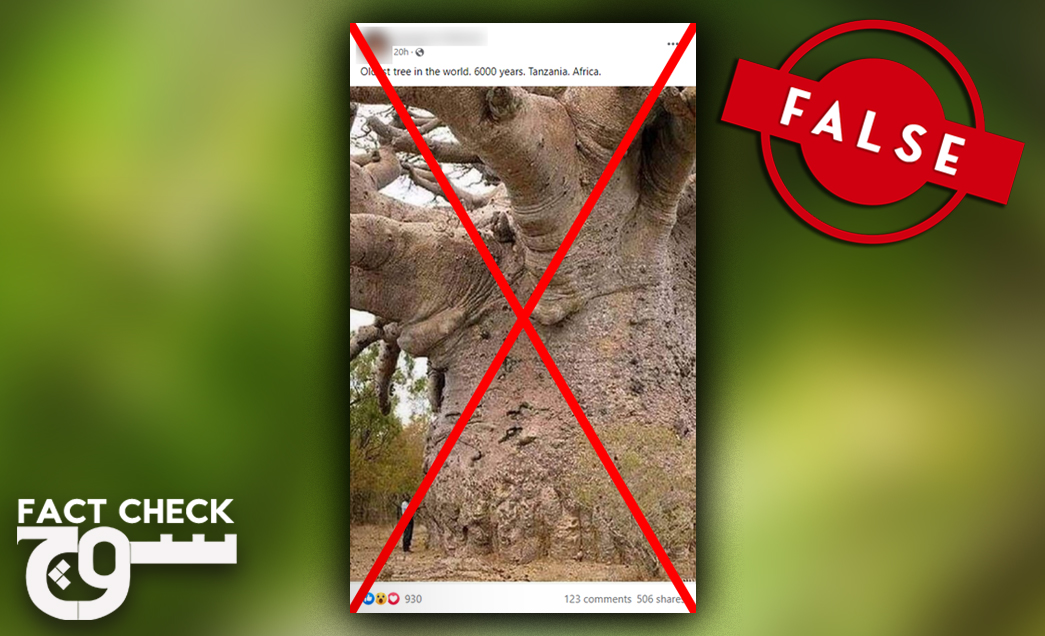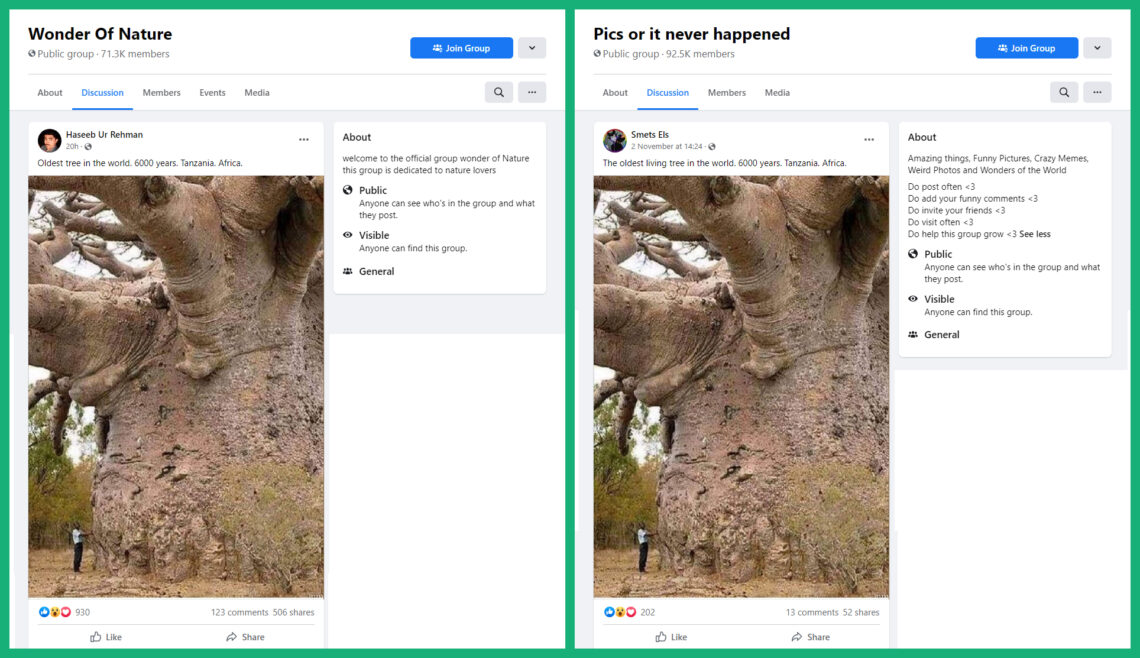
Claim: A photograph shows the oldest tree in the world, a 6,000 year old giant tree in Tanzania.
Fact: To date, no tree in the world has been verified to be 6,000 or more years old. The oldest living non-clonal tree on record is a more than 4,800-year-old bristlecone pine called ‘Methuselah’ in the Inyo National Forest, United States. ‘Prometheus’, an over 4,900-year-old bristlecone pine, died in the 1960s.
On 3 November 2021, an individual shared a photo of a giant tree with a man standing by its side to a Facebook group called ‘Wonder Of Nature.’ The image was captioned as, “Oldest tree in the world. 6000 years. Tanzania. Africa.”
The tree definitely appears to be very old as it has a very thick trunk, muscular branches, and wrinkles all over. The man by its side appears tiny in comparison.
Soch Fact Check was sent a link to the post, which has close to 1,000 reactions, over 500 shares, and more than 100 comments.
A Google Reverse Image Search turned up “6000 year old baobab tree senegal” as a suggested search term. It also revealed that the same photo has been used countless times on various websites, social media platforms, and elsewhere on the Internet.
Soch Fact Check ran a CrowdTangle analysis using the caption shared alongside the photo in the Facebook group. Over 20 Facebook posts, which amassed more than 8,200 interactions since 2 November 2021, used the same caption; there were no posts with the caption prior to that in the past 12 months.
The first Facebook post in this period was in a group called ‘Pics or it never happened’ on 2 November 2021 and it garnered over 2,400 reactions, over 1,000 shares, and more than 200 comments. It is also performing close to 50 times better than similar posts.
Soch Fact Check could not independently verify the existence or location of the tree in the photo; however, TinEye and Bing Reverse Image Searches revealed that the photo first surfaced on the internet in posts dating back to 5 February 2008 and 28 May 2008, respectively.

Soch Fact Check also found that the image has been fact checked by other International Fact-Checking Network (IFCN) partners, including AfricaCheck, Snopes, and AFP Fact Check.
The photo, as well as other similar ones, have repeatedly been shared on the Internet with the claim that the trees in those images are the oldest in the world. When Soch Fact Check conducted the CrowdTangle analysis for a 12-month period, two other posts (here and here) also cropped up, both shared with the claim that the oldest tree in the world is pictured.
In April 2021, AFP Fact Check published a fact check in which debunked the claim that a baobab tree — the same as the one Soch Fact Check is investigating — is the oldest one in the world. “The oldest living tree on record is a bristlecone pine in the United States,” the AFP report said, adding that no tree so far has been verified to be 6,000 or more years old.
According to AFP Fact Check, the image has been in circulation since 2004 and the oldest baobab tree, according to the Nature research journal, was in fact located in Zimbabwe — the tree turned 2,450 years old before it fell over and died.
In March 2021, AfricaCheck verified the authenticity of a tree with a twisted trunk, as shown in the second of the two aforementioned Facebook posts, noting that it was a more than 4,800 years old bristlecone pine called ‘Methuselah’ in the Inyo National Forest. It is documented on the United States Forest Service’s (USFS) website. ‘Prometheus,’ similar to ‘Methuselah,’ was another similar tree but it died at 4,900 years old.
In August 2019, Snopes wrote a fact check about the same image now being circulated, stating that the tree in question was neither the oldest nor 6,000 years old. It noted that ‘Prometheus’ was cut down for ring-based tree age analysis in the 1960s. ‘Sunland Baobab,’ a now dead tree within which humans had built a pub, was once thought to be over 6,000 years old but carbon dating determined it to be 1,060 years old, according to Snopes.
All the aforementioned trees are non-clonal, which means that the age of the trunk and the roots is the same. Clonal trees, on the other hand, multiply by cloning themselves, which means that their system may be old but their trunks could be younger.
Interestingly, the caption of the post in question cites Tanzania as the location of the world’s oldest tree; however, in previous posts that shared the image, it was claimed the location was Senegal. The photo, therefore, appears to be one of many serial false claims that make the rounds every few years.
Conclusion: The image in question does show a baobab tree but the oldest living and dead trees on record are over 4,800 years old and 4,900 years old, respectively.
